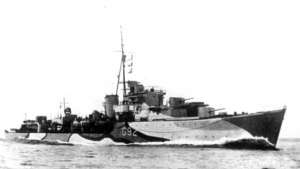- Author
- Hayles, Max
- Subjects
- RAN operations, Ship histories and stories
- Tags
-
- RAN Ships
- HMAS Quickmatch
- Publication
- June 2007 edition of the Naval Historical Review (all rights reserved)
A slice of Naval life…I’m sure we’ve all been involved in something similar during our life at sea.
On September 30th 1944, HMAS Quickmatch was emergency destroyer in Trincomalee harbour, Ceylon (now Sri Lanka) moored at buoy D13. Steam for full speed was at thirty minutes’ notice.

(Image: Seapower Centre, Australia)
Near midnight, a signal was received to put to sea to rendezvous with HMS/M Statesman, an ‘S’ Class submarine, to take off their First Lieutenant who had been taken ill with severe appendicitis. The sub was said to be approximately 150 nautical miles North of the Nicobars, in the Bay of Bengal.
As a signalman, my next watch on the bridge was the Middle Watch (the one we all loved), but I was woken at 2300 for sea duty, and took position on forecastle with Aldis lamp for slipping the cable from the buoy.
We proceeded to sea at 0015 at 25 knots, and later increased to 29 knots. After 30 hours steaming, the submarine was not in the rendezvous position, according to our Navigator. We searched around at 15 knots, but the submarine found us first and fired a red flare at 0510, Oct 2nd, 30 degrees on starboard bow. The required challenge was made and Statesman made the correct reply.
All hands were on deck, the forward port whaler was manned. It included myself with the obligatory pair of semaphore hand flags and an Aldis lamp complete with heavy battery on leather strap around my neck.
Due to the heavy swell running, the Captain slewed Quickmatch around to create a slick, and released some oil, whilst the whaler was lowered to the waterline. The coxswain waited until the crest of a wave swept under us, and yelled to two seamen to trip to falls.
Unfortunately, only one slip opened and we found ourselves hanging at about 45 degrees until the next swell swept through and then we were away. Meanwhile Statesman had surfaced, and was wallowing heavily in the swell.
By the time the seamen had sorted themselves out, positioned their oars, and started rowing, the whaler had been swept some distance away from the submarine, and the going was pretty tough. I had positioned myself on the deck in the bow, sitting in about a foot of water.
Then we were alongside the submarine, where several of its crew were on deck including the First Lieutenant who was firmly encased in a stretcher. The big problem was that with the submarine’s bulbous sides, we could not really get alongside. Time and again we were carried up on a swell, only to collide heavily with the bulge and slither sideways back into an angry swell.
Our seamen struggled to gain control by fending off, with oars flailing everywhere. In trying to help I was struck heavily in the back by the butt end of an oar.
At one stage, the handle end of an oar became firmly jammed in one of the submarine’s flooding slots, and had to be dodged by the crew until it could be recovered. With the whaler rising and falling several feet, sometimes the oar would crash into the boat, or be overhead of the crew.
Attempts to keep alongside were impossible, and there was a risk of the whaler being destroyed, so it was decided that the only way to get the sick man on board was to throw him broadside on into the whaler. Two of our biggest and strongest seamen stood up in the boat, whilst two others tried to hold on to them.
On the count of three, the First Lieutenant was thrown bodily, caught successfully, and laid across two thwarts. His case of personal effects was thrown to me, which I caught. We threw a bag of bread to the submarine’s crew, and then we were away.
We all returned to the ship soaking wet. The boat was hoisted aboard and after a change of clothes, we resumed our watch duties.
Quickmatch turned into the wind at 11 knots to make things as smooth as possible and the First Lieutenant was operated on immediately. When it was all over, we turned for Trincomalee at 22 knots, and arrived at 0630 next day.




